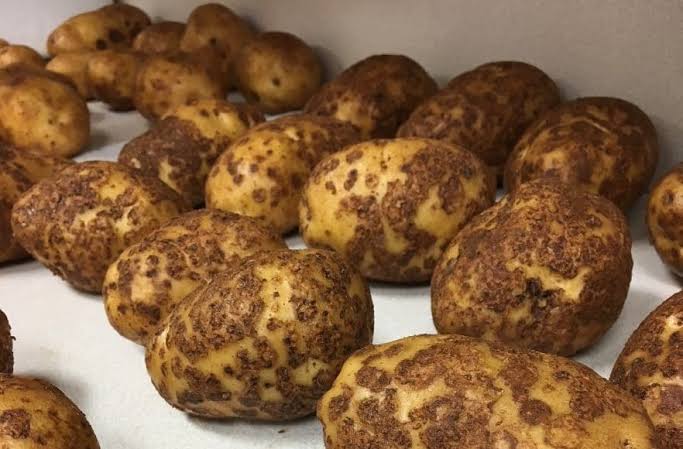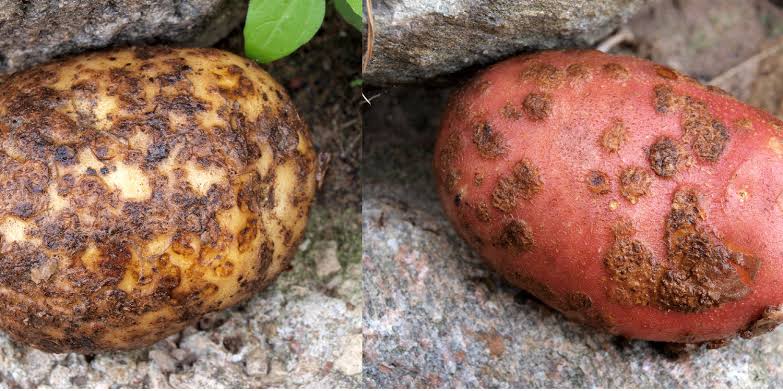Powdery scab, scientifically known as Spongospora subterranea, is a troublesome disease affecting potatoes, one of the world’s most essential crops. This microscopic pathogen can cause significant damage to potato tubers, impacting both quality and yield.
The first sign of powdery scab is often subtle – small, powdery pustules on the surface of the tubers. These pustules may appear inconspicuous at first, but they house the infective stages of the pathogen, ready to wreak havoc on the potato crop. As the disease progresses, the affected tubers can develop lesions and become distorted, leading to economic losses for farmers.
Spongospora subterranea has a unique life cycle, involving multiple stages. It starts as a resting spore in the soil, waiting for a potato host. Once a susceptible host is found, the spore germinates, forming motile structures known as zoospores. These zoospores swim through the soil moisture, seeking entry points on potato roots.
Upon finding a suitable entry, the zoospores invade the root cells, initiating the infection process. The pathogen manipulates the host cells, forming the characteristic pustules on the potato’s surface. Inside these pustules, the pathogen produces spores, which are released into the soil, perpetuating the cycle.
Managing powdery scab poses a considerable challenge for potato farmers. Crop rotation, the use of resistant potato varieties, and proper sanitation practices are crucial in preventing and controlling the disease. Additionally, soil health management and the application of fungicides can be employed to mitigate the impact of S. subterranea.
Researchers and agricultural experts continually strive to develop new methods to combat powdery scab, understanding the importance of sustaining potato production for global food security. Collaborative efforts between scientists, farmers, and policymakers are essential to address the complex challenges posed by this potato disease.
However, powdery scab, caused by Spongospora subterranea, underscores the intricate relationship between crops and pathogens. Its impact on potato crops emphasizes the need for integrated pest management strategies to ensure the continued productivity of this vital food source.
Read Also: Appearance, Features and Farming Guide of Pangasius Fish
Plants Affected by Powdery Scab (Spongospora subterranea)

Powdery scab primarily affects potatoes (Solanum tuberosum), which are the main host for the pathogen Spongospora subterranea. This pathogen specifically targets the roots and tubers of potatoes, causing visible symptoms on the tuber surface. While other plants are not directly affected by powdery scab, it is crucial to note that the disease can persist in the soil.
In the soil, S. subterranea produces resting spores that can survive for extended periods, even in the absence of a potato host. Although these spores don’t actively infect other types of plants, they can serve as a potential source of contamination for potato crops in subsequent planting seasons.
To minimize the risk of powdery scab in potato production, farmers often practice crop rotation with non-host plants, reducing the likelihood of disease recurrence. This preventive measure helps break the cycle of infection and maintains the health of potato crops over time.
Additionally, while powdery scab primarily affects potatoes, its ability to persist in the soil emphasizes the importance of integrated management practices, including crop rotation, to mitigate the risk of disease and ensure the sustained health of potato crops.
Damages Caused by Powdery Scab (Potatoes)

Powdery scab, caused by the pathogen Spongospora subterranea, inflicts significant damage on potato crops, impacting both quantity and quality. The damages manifest in various ways, affecting different parts of the potato plant:
1. Tuber Deformities: One of the most noticeable effects of powdery scab is the development of pustules on the potato tubers. These pustules can lead to deformities and surface blemishes, diminishing the overall quality and market value of the harvested potatoes.
2. Reduced Yield: Powdery scab can result in a reduction in potato yield. Affected tubers may be smaller in size, and the overall crop output may decline due to the compromised health of the plants.
3. Quality Deterioration: The disease can cause internal damage to potato tubers, affecting their texture and taste. Infected potatoes may exhibit a powdery or corky texture, making them less appealing to consumers and reducing their suitability for processing.
4. Storage Issues: Potatoes infected with powdery scab may experience difficulties in storage. The compromised tubers are more susceptible to rot and other storage diseases, leading to additional losses post-harvest.
5. Economic Impact: Farmers face economic challenges as a result of reduced yield and lower-quality potatoes. The decrease in marketable produce can result in financial losses and negatively impact the livelihoods of those dependent on potato cultivation.
Mitigating the damages caused by powdery scab involves implementing effective management strategies, including crop rotation, the use of resistant potato varieties, and proper soil health management. Timely and accurate diagnosis of the disease is crucial to implementing appropriate control measures and minimizing the impact on potato production systems.
Read Also: How to Farm and Care for Longtail Tuna Fish (Thunnus tonggol)
Control and Preventive Measures
Controlling and preventing powdery scab in potatoes, caused by Spongospora subterranea, involves a combination of cultural, biological, and chemical measures. Here are key strategies:
1. Crop Rotation: Implementing a well-planned crop rotation is fundamental. Avoid planting potatoes or other susceptible crops in the same field consecutively. Rotating with non-host crops helps break the disease cycle and reduces the pathogen’s presence in the soil.
2. Resistant Varieties: Utilize potato varieties that have been bred for resistance to powdery scab. Resistant cultivars can withstand infection better, leading to healthier plants and reduced disease severity. Regularly update crop varieties based on the latest resistance traits.
3. Sanitation: Practice good field sanitation to minimize the spread of the pathogen. Remove and destroy infected plant debris and volunteer potato plants. Thoroughly clean equipment used in potato fields to prevent the transportation of contaminated soil.
4. Soil Health Management: Maintain optimal soil conditions to discourage the development and survival of the powdery scab pathogen. Proper irrigation, drainage, and organic matter management contribute to a healthier soil environment.
5. Fungicides: In severe cases, fungicides may be used to control powdery scab. However, this approach is typically considered a last resort due to environmental concerns and the potential development of resistant strains. If fungicides are used, follow recommended application guidelines.
6. Early Detection and Monitoring: Regularly scout fields for signs of powdery scab, especially during the growing season. Early detection allows for prompt action, reducing the risk of widespread infection. Monitoring can include visual inspections and, if available, soil testing.
7. Avoid Overhead Irrigation: Minimize the use of overhead irrigation systems, as wet conditions can favor the spread of the powdery scab pathogen. Opt for drip or furrow irrigation to keep foliage dry and reduce the risk of infection.
8. Educational Programs: Promote awareness and education among farmers about the symptoms of powdery scab and the importance of implementing preventive measures. Extension services and agricultural agencies play a crucial role in disseminating information and best practices.
By integrating these measures into a comprehensive management plan, farmers can reduce the impact of powdery scab on potato crops, ensuring sustainable and healthy potato production.
Frequently Asked Questions (FAQs) About Powdery Scab (Spongospora subterranea)
1. Q: What is powdery scab in potatoes?
A: Powdery scab is a plant disease caused by the pathogen Spongospora subterranea. It affects potatoes, leading to the formation of powdery pustules on the tubers and impacting their quality and yield.
2. Q: How does powdery scab spread?
A: Powdery scab spreads through soil-borne spores produced by the pathogen. These spores can persist in the soil and infect potato plants when conditions are favorable.
3. Q: What are the symptoms of powdery scab?
A: Symptoms include powdery pustules on the surface of potato tubers, which can lead to deformities. The disease can also cause internal damage, affecting the texture and taste of the potatoes.
4. Q: Can other plants be affected by powdery scab?
A: While other plants are not directly affected, S. subterranea can persist in the soil. Crop rotation with non-host plants is essential to prevent the disease from recurring in subsequent potato planting seasons.
5. Q: How can farmers control powdery scab?
A: Control measures include crop rotation, using resistant potato varieties, practicing good sanitation, managing soil health, and, in severe cases, employing fungicides. Early detection and monitoring are also crucial.
6. Q: Are there potato varieties resistant to powdery scab?
A: Yes, there are potato varieties bred for resistance to powdery scab. Planting resistant cultivars is an effective strategy to minimize the impact of the disease on potato crops.
7. Q: What is the economic impact of powdery scab on potato farming?
A: Powdery scab can lead to reduced yield, lower-quality potatoes, and economic losses for farmers. The disease affects the marketability of the harvested potatoes and impacts the livelihoods of those dependent on potato cultivation.
8. Q: Can fungicides be used to control powdery scab?
A: In severe cases, fungicides may be used as a last resort. However, this approach is carefully considered due to environmental concerns and the potential development of resistant strains.
9. Q: How can farmers prevent the recurrence of powdery scab in their fields?
A: Preventive measures include crop rotation, using resistant potato varieties, maintaining good field sanitation, managing soil health, and adopting irrigation practices that minimize wet conditions, which favor the spread of the pathogen. Regular monitoring is also crucial.
10. Q: What role do educational programs play in powdery scab management?
A: Educational programs are essential for raising awareness among farmers about the symptoms of powdery scab and the importance of implementing preventive measures. Extension services and agricultural agencies play a crucial role in disseminating information and best practices.
Read Also: Top 20 Proven Benefits of Ginger Plant
